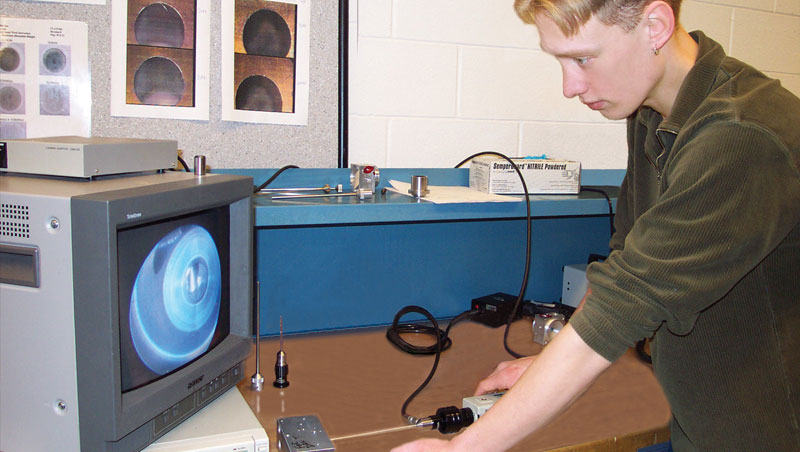General Automotive Manufacturing

Making Quality Portable
General Automotive Manufacturing Plant Finds Borescopes Improve Quality Control by Decentralizing Visual Inspection
The Situation
General Automotive Manufacturing Co. LLC (GAM) produces machined metal parts used in fuel systems, hydraulic assemblies, brake systems, and gas and diesel engines. Some of GA’s major clients include Caterpillar, International, Mercury Marine, Stanadyne, Cummins, Actuant and Sheppard.
General Automotive has been in business since 1950. The company specializes in machining components from steel (carbon, alloy and stainless steel) and aluminum (from bar stock, cast or extrusions). Its range of expertise, however, means that General Automotive handles all types of components and materials–from gray iron and ductile iron castings to stainless steel forgings–and can provide the fixtures, machine tools and tooling for even very complex components. The company uses the same industry-leading machining processes of products throughout a wide range of material, heat treat, plating and geometric shape and size requirements. In addition to the traditional manufacturing processes General Automotive also offers in-house honing, lapping, ECM, glass beading, assembly and testing of customer products.
The Need
General Automotive in some instances had found burrs and other part defects that its manufacturing team had not detected before the parts were final inspected by the quality department. Thus, General Automotive had to reprocess “blindly” because it couldn’t “see” the defect at the manufacturing cell level. This reprocessing was expensive and time-consuming.
The problem was obvious: Burrs, sharp edges and other defects can be extremely detrimental, especially to mission-critical parts. According to Quality Manager Gary Kosterman, “If you have sharp edges or small burrs, they can erode and eventually clog a system, preventing it from working properly. That’s especially true in hydraulic and fuel systems, which have extremely small openings that can become clogged.” Without a more effective inspection process, GAM would continue to spend more time and money than necessary to undertake the vital containment of defects.
General Automotive wanted to do several things. It needed to find inspection tools that could be used inside deep bores and in small-diameter holes. It also needed to report defects and process problems much more quickly to manufacturing teams in order to assure no incidence of defects and meet its promise of 100 percent on-time delivery of orders. As well, the company wanted a tool that it could use both in the quality lab and on the manufacturing floor.
General Automotive’s need went deeper than just satisfying its customers. The company is committed to a “zero defect” philosophy, even empowering employees to prevent shipment of product to customers if there is any quality concern. So the company’s culture made imperative the solution of the problem at hand.
The Answer
To assure the success of its zero-defect and on-time-delivery quality policies, General Automotive’s Quality Engineering and Metrology Teams worked together with supplier partner Gradient Lens Corporation to find a solution. Gradient Lens had developed a patented relay lens design , allowing the production of high-quality, portable borescopes able to be sold at half the price of traditional models. Gradient Lens’s portable line of borescopes – called Hawkeye Precision – can go anywhere in a manufacturing plant with ease.
The scopes’ lens systems are made with chemically treated glass that requires fewer lenses in each scope. Since the price of the equipment goes up dramatically with each lens required, Gradient Lens can produce Hawkeye Borescopes at a fraction of the cost of other scopes of comparable quality.
According to Kosterman, the borescopes fit conveniently into multiple work cells where necessary. Each cell (which could, for instance, include a lathe, machining center and gun drill) is a self-contained manufacturing team that includes a visual inspection station. The inspection stations are equipped with a Hawkeye borescope, a portable or fixed light source and often a video system (with camera and monitor) connected to the borescope. The system allows operators to view part images on screen rather than through the scope, which reduces eye strain for operators who might spend a good deal of their day visually inspecting components. The monitor also provides a larger viewing image, which makes detecting imperfections easier, and group viewing possible.
More important, the system provides immediate detection capabilities at the point of operation and allows containment of defects early in the manufacturing process. For example, if a gun drill operator receives a part from the machining center and detects a bad surface finish or large burr in a deep hole produced at the machining center, the gun drill operator can immediately raise a red flag to contain the problem.
“This cell concept vs. batch process also allows our operators to have direct input in process improvement,” Kosterman says. “We’ve learned that borescope visual inspection is as important to our manufacturing and quality processes as some of our metrology procedures. Before working with Gradient Lens Corporation, we had tested competitive borescope brands. None compared with the versatility, quality, and affordability of Hawkeyes.”
Although the borescope’s primary function is checking machined parts, engineers also use them to diagnose the cause when an assembly line machine is having trouble. General Automotive engineers have found that the borescopes save them time and labor, as well as giving them the accurate images they need. Ultimately, the Hawkeye borescope gives the company a cost-effective way to continually increase quality standards without slowing down production.
Says Kosterman, “The Hawkeye scopes help with our mission of 100 percent on-time delivery because we can use them for many different kinds of inspection on the floor, instead of having to take a component into a lab for inspection.” Early detection, he adds, “is key. Containment is easier, as is changing the manufacturing process when we need to.”
General Automotive’s visual inspection process also helps in customer relations, according to Kosterman: “The borescopes help demonstrate capabilities not found in most other manufacturing facilities. Customers are impressed with our inspection capabilities that the borescopes provide.”
GAM is QS9000 registered with plans to be TS 16949 registered in 2005.